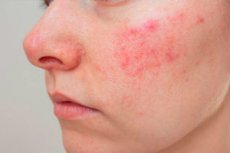Nye publikasjoner
Studie finner signifikant sammenheng mellom rosacea og malignt melanom
Sist anmeldt: 02.07.2025

Alt iLive-innhold blir gjennomgått med medisin eller faktisk kontrollert for å sikre så mye faktuell nøyaktighet som mulig.
Vi har strenge retningslinjer for innkjøp og kun kobling til anerkjente medieområder, akademiske forskningsinstitusjoner og, når det er mulig, medisinsk peer-evaluerte studier. Merk at tallene i parenteser ([1], [2], etc.) er klikkbare koblinger til disse studiene.
Hvis du føler at noe av innholdet vårt er unøyaktig, utdatert eller ellers tvilsomt, velg det og trykk Ctrl + Enter.

En fersk studie publisert i tidsskriftet Scientific Reports har funnet at rosacea, en vanlig hudtilstand som vanligvis anses som et kosmetisk problem, kan være assosiert med flere relaterte tilstander, inkludert melanom.
Studien brukte en stor alders- og kjønnsmatchet kohort hentet fra TriNetX-plattformen (n = 244 888) som inkluderte etnisiteter av kaukasisk, svart, asiatisk, alaskisk og stillehavsøyboerskare.
Studieresultatene viser at rosacea, i motsetning til tidligere forskning, er signifikant assosiert med økt risiko for synshemming, metabolske forstyrrelser, leddproblemer og type 2 diabetes (T2D).
Spesielt den kaukasiske undergruppen viste en betydelig økt risiko for melanom, noe som ikke ble observert i den asiatiske undergruppen. Disse etniske forskjellene kan forklare de inkonsistente rapportene om komorbiditeter i tidligere studier.
Til tross for de bemerkelsesverdige begrensningene ved den retrospektive studiedesignen, rettferdiggjør den behovet for videre forskning på patologien til denne vanlige, men dårlig forståtte sykdommen.
Hva er rosacea, og hvorfor har det vært under radaren til epidemiologer så lenge? Rosacea er en kronisk hudsykdom som primært forårsaker rødhet og utslett på kinn, hake, nese og panne hos berørte personer. Tilstanden er vanligst hos kvinner i alderen 30–50 år, selv om den kan ramme personer i alle aldre og kjønn.
Globale rapporter indikerer at personer av keltisk avstamning og lyshudede nordeuropeere er mer sårbare for sykdommen, med en prevalens blant disse etniske gruppene anslått til å være mellom 5 og 10 %, sammenlignet med et globalt estimat på 1–7 %.
Selv om rosacea ble beskrevet så tidlig som Geoffrey Chaucers Canterbury Tales på slutten av 1300-tallet og muligens så tidlig som 200 f.Kr. av Theokrit, er det fortsatt dårlig forstått.
Selv om en rekke årsaker til sykdommen har blitt foreslått, inkludert ultrafiolett eksponering, røyking, alkohol, varme, trening, psykisk stress og, oftest, genetikk, har disse årsakene aldri blitt vitenskapelig bevist.
Nyere studier har knyttet Demodex -infeksjoner til rosacea-manifestasjoner, noe som har ført til at orale antibiotika blir den kliniske intervensjonen man velger når symptomer oppstår. Disse intervensjonene gir imidlertid bare midlertidig lindring, og det finnes for øyeblikket ingen langsiktig kur for sykdommen.
Denne studien hadde som mål å bruke data fra en stor database fra den virkelige verden (TriNetX-plattformen) retrospektivt for å identifisere mulige korrelasjoner mellom rosacea og flere systemiske sykdommer, inkludert maligniteter.
Dataene ble innhentet fra 21 913 235 registrerte TriNetX-pasienter mellom juni og juli 2023 og inkluderte både demografi (spesielt alder, kjønn og etnisitet) og medisinske journaler (diagnoser, medisiner, laboratorieobservasjoner og genomisk informasjon).
Inklusjonskriteriene for studien inkluderte pasienter diagnostisert med International Classification of Diseases and Related Health Problems (ICD-10) kode L71 (rosacea) og et tilsvarende antall pasienter uten en diagnose av rosacea, matchet for alder og kjønn, inkludert som en kontrollgruppe.
Av 132 388 pasienter diagnostisert med ICD-10-kode L71 (rosacea), hadde 122 444 (69,2 % kvinner) alders- og kjønnsmatchede pasienter uten en diagnose av rosacea og ble inkludert i denne studien. Av disse var 82 % kaukasiske, 3 % var svarte, 1,6 % var asiatiske, 10 % var ukjente, og resten var alaska-, indianer-, hawaii- eller stillehavsøyboere.
«Mens risikoen for å bli diagnostisert med karsykdom var 0,185 hos pasienter uten rosacea, økte denne risikoen til 0,336 hos pasienter med rosacea [OR 2,234 (2,192, 2,276)].»
I motsetning til tidligere rapporter ble rosacea funnet å være assosiert med en signifikant økning i risikoen for hjertesykdom (OR = 1,649), type 2 diabetes (T2D; OR = 1,618), metabolske sykdommer (OR = 3,165) og øye- eller leddsykdommer (OR = 4,164–4,801).
Av størst bekymring er komorbiditetene som er sterkest assosiert med rosacea, inkludert kutane neoplasmer (inkludert malignt melanom; OR = 6,031).
«I en undergruppeanalyse av rosacea-pasienter med kutane neoplasmer, kunne vi ikke bare identifisere en økt risiko for ikke-melanom hudkreft [C44; OR 5,550 (5,345, 5,763)], men også malignt melanom (C43) [OR 4,468 (4,144, 4,818)]. Gitt den kraftig økte risikoen for malignt melanom i vår rosacea-populasjon, utførte vi en Kaplan-Meier overlevelsesanalyse for denne undergruppen av pasienter. Sannsynligheten for overlevelse ved slutten av tidsvinduet var henholdsvis 92,51 % og 97,71 % for kohorten med og uten rosacea. Med en HR på 3,286 (95 % KI 3,101, 3,481) var dødeligheten høyere hos pasienter med malignt melanom hvis de også hadde rosacea (p = 0,059).»
Alt i alt er denne studien den første som overbevisende knytter rosacea til en rekke komorbiditeter, hvorav noen (melanomer og hjertesykdom) er livstruende.
Til tross for de bemerkelsesverdige begrensningene ved kun å bruke retrospektive data og ICD-10-koder, fremhever studien viktigheten av rosacea og behovet for videre forskning på denne tilsynelatende ufarlige sykdommen.
